Table of Contents
ToggleWhat is an Outdoor Badminton Court Lighting Design?
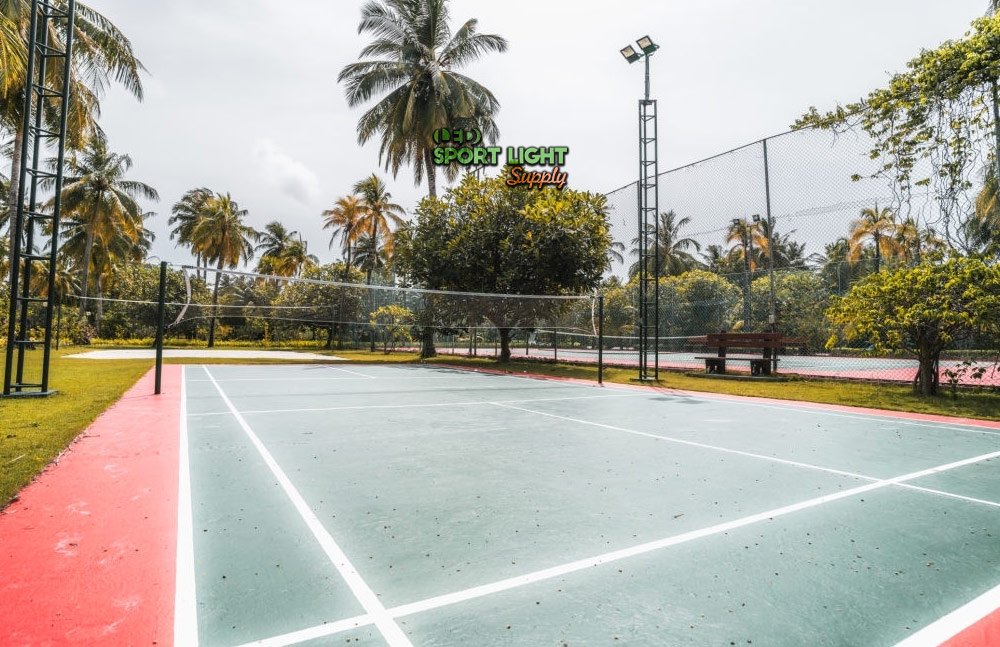
An outdoor badminton court lighting design focuses on ensuring optimal illumination for various levels of play and activities. Proper lighting is crucial for extending play into the evening or night, enhancing visibility, and ensuring a consistent and high-quality playing experience. This design involves strategic planning regarding the placement of light poles, their height, and the specific lighting fixtures used to achieve the desired lighting effect. Key factors include the number of light poles, their positions, the height of the poles, and the technical specifications of the lights themselves, such as lumen output, lux levels, and beam angles. Additionally, considerations such as lighting uniformity, spill light control, and waterproof ratings are essential to ensure durability and effectiveness in varying weather conditions.
How to Get Started with Lighting Design for an Outdoor Badminton Court
When beginning the design of lighting for an outdoor badminton court, several critical aspects must be addressed to achieve the best results. These include the number of light poles, their positions, pole height, and various technical specifications.
Number of Light Poles
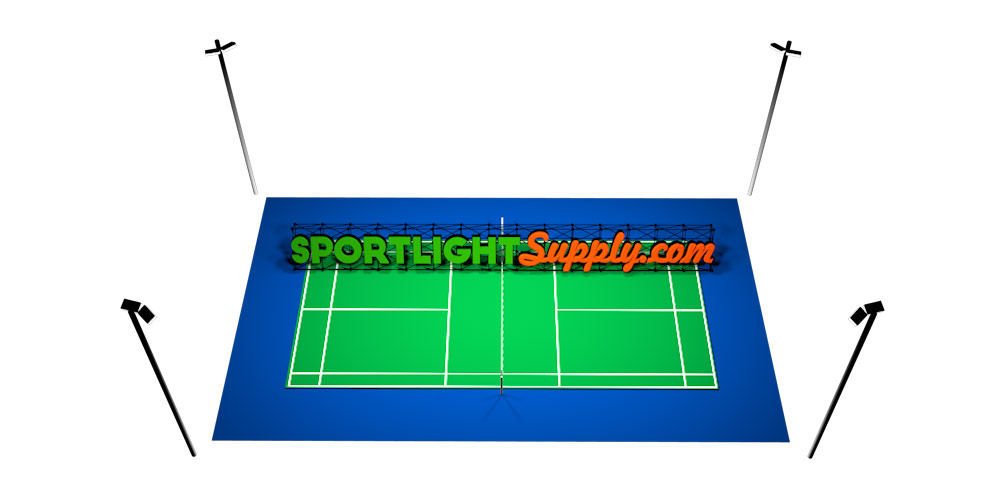
The number of light poles required for an outdoor badminton court typically ranges between four and eight, depending on the level of play and the desired lighting quality. A standard setup often includes four poles, which are suitable for recreational use and smaller courts. For higher levels of play, such as competitive training or community competitions, six poles may be necessary to ensure more even light distribution and reduce shadows. In cases where the court is used for national or international tournaments, eight poles may be employed to achieve the highest level of lighting uniformity and meet broadcast standards.
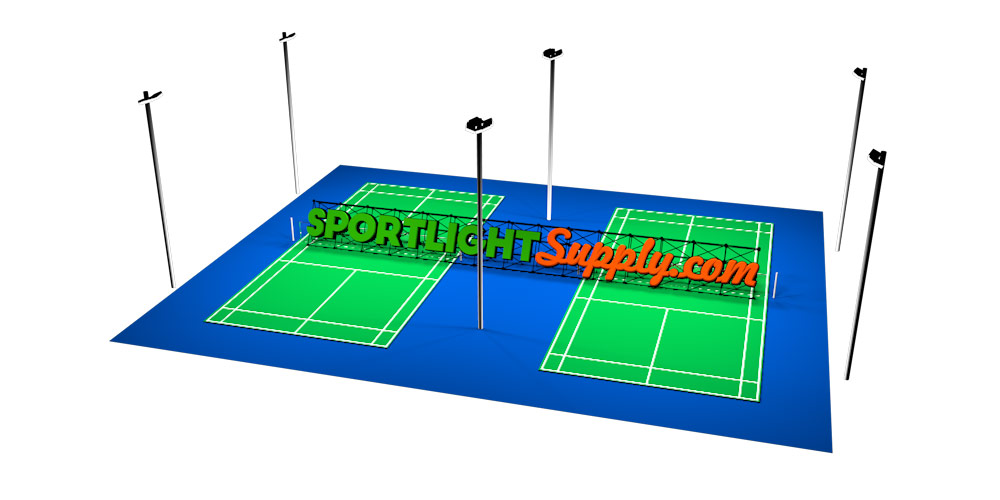
Pole Position
The positioning of the light poles is crucial for effective lighting. Generally, poles should be placed along the sidelines of the court, with additional poles at the corners. This arrangement helps to minimize shadows and ensures that the entire playing area is evenly illuminated. The distance of the poles from the court edges must be carefully measured to avoid interference with play while maximizing light coverage.
Badminton Court Light Pole Height
The height of the light poles significantly affects the quality of illumination. For outdoor badminton courts, poles should be at least 30 feet tall. This height helps in achieving uniform light distribution across the court and reduces the intensity of shadows. The poles must be positioned outside the court’s boundaries to avoid obstructing the players’ view and the flight of the shuttlecock. Ensuring that the poles are clear of obstructions such as trees is also essential for maintaining optimal light coverage.
Lumen and Lux of Outdoor Badminton Court Lights
The lumen and lux levels of the lighting fixtures are critical in determining the quality of light on the court.
| Levels of Competition | Recommended Lux Level | Description |
|---|---|---|
| Recreational | 200-300 lux | Adequate for casual play, providing sufficient illumination for players to enjoy the game without intense lighting. |
| Training | 300-500 lux | Supports more serious practice sessions, helping players hone their skills effectively. |
| Community Competition | 500-700 lux | Ensures the court is well-lit for both players and spectators, suitable for television coverage if needed. |
| National or International Tournaments | 1000-2000 lux | Meets stringent requirements for television broadcasting and detailed play analysis, ensuring high-definition video capture and precise visibility. |
Lighting Uniformity
Uniformity of lighting is essential for providing a consistent playing experience. It minimizes shadows and ensures that every part of the court is equally lit. Lighting uniformity is typically assessed through horizontal and vertical measurements to confirm that the illumination levels are consistent across the entire playing surface. This aspect is particularly important for professional and competitive play, where even slight variations in lighting can affect performance and fairness.
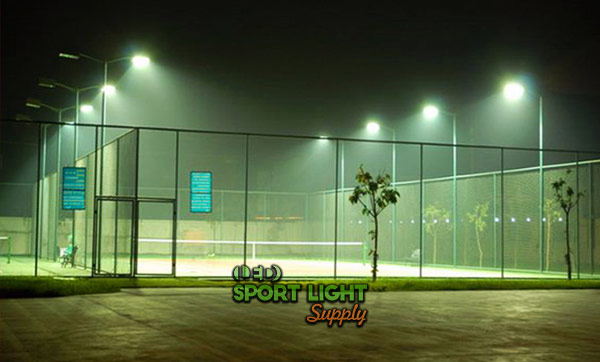
Spill Light
Spill light, or light pollution, occurs when light escapes beyond the intended area. This can be managed by carefully selecting the beam angles and using fixtures designed to minimize spill light. Effective control of spill light is important for reducing glare and ensuring that adjacent areas, such as spectator zones, are not adversely affected. Directional LED lights can help to minimize spill light and maintain focus on the court.
Beam Angle
The beam angle of the lights affects how the light is spread across the court. For professional courts, precise beam angles are calculated using computer models to ensure optimal coverage. Floodlights and spotlights may be used in different configurations depending on the desired lighting effect. Proper beam angle adjustments are crucial for achieving the right balance of illumination without creating hot spots or overly dim areas.
Angle of Projection
The angle of projection refers to how the light is directed towards the court. Since some light is inevitably lost during projection, adjustments are made to account for this loss and ensure that the required lumen levels are maintained. By factoring in potential light loss, the lighting design can provide consistent illumination across the court.
Color Temperature
Color temperature, measured in Kelvin (K), affects the appearance of the light. For badminton courts, a color temperature of 5000-6000K is ideal, providing a daylight-like quality that enhances visibility and contrast. Lower color temperatures, such as 4000-4500K, may be used for practice courts. Warmer color temperatures, including red or pink hues, are generally avoided as they can distort the visibility of the shuttlecock.
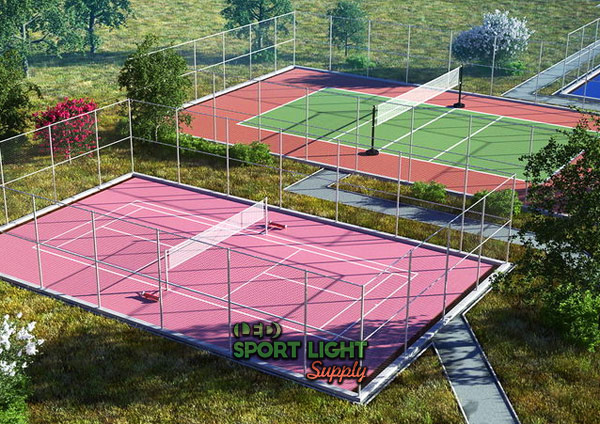
Waterproof Rating of Outdoor Badminton Lighting
Given the outdoor setting, the lighting fixtures must be rated for weather resistance. An IP (Ingress Protection) rating of at least IP65 is recommended to ensure that the lights are protected from rain and dust. Higher IP ratings, such as IP66 or IP67, provide additional protection and extend the lifespan of the fixtures in harsh weather conditions.
Importance of Getting a Good Lighting Layout for Outdoor Badminton Court
A well-designed lighting layout is crucial for various reasons, enhancing the overall functionality and appeal of the badminton court.
Better Vision for Badminton Players
Proper lighting ensures that players have clear visibility of the shuttlecock and their surroundings. Adequate brightness and uniform illumination reduce shadows and improve the players’ ability to track fast-moving objects, thereby enhancing their performance and safety.
For Broadcasting Events
High-quality lighting is essential for broadcasting events. It ensures that cameras capture clear, high-definition footage, which is crucial for both live broadcasts and replays. Good lighting enhances the visual appeal of the court and helps in showcasing the event effectively to viewers.
Attract More Players
Well-lit courts are more inviting and can attract a greater number of players. Facilities with superior lighting are likely to be preferred by serious players and those who wish to practice in the evenings. This can boost participation and foster a stronger community around the sport.
For Security and Management
Effective lighting also contributes to security by illuminating the court area during off-hours. This helps in monitoring the premises through CCTV cameras and deterring unauthorized access. Proper lighting is a valuable asset for maintaining the security and management of the facility.
Conclusion
Designing effective lighting for an outdoor badminton court involves careful consideration of multiple factors, including the number and placement of light poles, pole height, and technical specifications such as lumen output, lux levels, and beam angles. Ensuring proper lighting uniformity, controlling spill light, and selecting appropriate color temperatures and waterproof ratings are also essential. A well-executed lighting design not only enhances the playing experience but also supports broadcasting needs, attracts more players, and improves security. By investing in high-quality lighting, facilities can create a superior environment for badminton players and elevate the overall appeal and functionality of the court.
